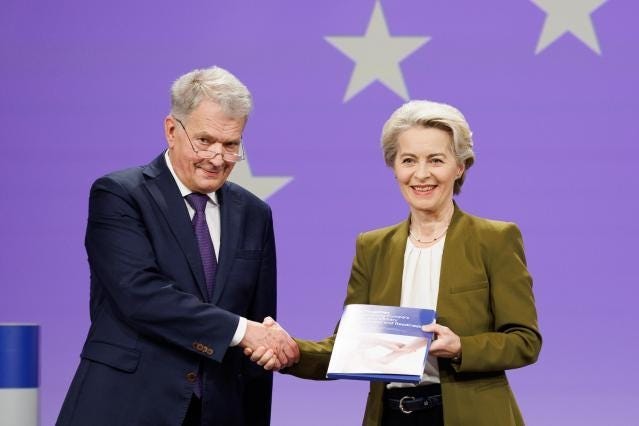Welcome! I’m Tom Griffin and this is my intelligence history newsletter. Feel free to share this article with the button below.
Special Adviser Sauli Niinistö presenting his report on report on strengthening Europe's civilian and military preparedness and readiness to European Commission President Ursula von der Leyen on 30 October (European Commission).
The EU should ‘create a CIA-style European spy service’. That was how Politico glossed a new report to EU Commission President Ursula von der Leyen from former Finnish president Sauli Niinistö.1
The more prosaic description in Niinistö’s text was ‘a fully-fledged intelligence cooperation service at the EU level that can serve both the strategic and operational needs of policy planning decision-making without emulating the tasks of Member States’ national intelligence organisations, including in respect of their role in intelligence gathering.’2
The formidable challenges in the way of this vision were pointed out in an X thread by US intelligence scholar Jeff Rogg, who wrote:
Coordination has been the albatross of American intelligence reform efforts since 1947. And that’s just for the intel services of one country. Interested to see where this proposal goes, but it has trouble written all over it…
Nobody who has looked at the US intelligence community’s history of cellular mitosis can doubt that Rogg’s warning is apposite. Yet European intelligence coordination may already be further along than Politico’s headline implies.3
Indeed, British intelligence scholar David Strachan-Morris suggests that the projected agency already exists in the form of the European Union Intelligence and Situation Centre (EU INTCEN).4
INTCEN’s roots lie in a long history of European intelligence co-operation through intergovernmental organisations like the Club de Berne. It originated under the aegis of the now defunct Western European Union, whose functions were gradually transferred to the EU’s Common Security and Defence Policy in the early 2000s.5
How far INTCEN looks like the germ of a European CIA depends partly on how one interprets the CIA’s role. For much of its history the agency had something of a Jekyll and Hyde identity that could almost have been created to illustrate competing definitions of intelligence.
Some definitions focus on intelligence as information, corresponding to the work of the Directorate of Analysis. Others emphasise intelligence as secrecy, embodied in the clandestine work of the Directorate of Operations, what most people think of when they hear the words CIA.
INTCEN’s role so far has been mainly on the analytical side. As part of the European External Action Service, it perhaps most resembles the State Department’s Bureau of Intelligence and Research. The co-ordination agency envisaged by Sauli Niinistö resembles the CIA’s old Intelligence Community Staff, which was eventually hived off, in one of those processes of cellular division, to the Office of the Director of National Intelligence.
Clandestine operations have apparently remained the prerogative of national agencies, though there are indications that the EU is more than simply a consumer in this respect. During the tenure of High Representative Javier Solana, a key figure in the development of INTCEN, MI6 officer Alastair Crooke was seconded to the EU in Jerusalem. Crooke’s contacts with Hamas could be interpreted as an EU covert operation. Equally, given Crooke’s characteristic approach, they might simply be seen as an exercise in discreet parallel diplomacy.
Developments under Solana were arguably a typical example of the EU’s development through crisis, with the crisis on this occasion being 9/11 and the War on Terror. Niinistö’s report reflects a similar impetus coming from the War in Ukraine.
The experience of the early 2000s suggests that the EU’s intelligence evolution may be more consensual than US precedents would lead us to expect. It may also be less transparent. It took the US Congress 30 years to undertake serious scrutiny of the CIA, and its hard to see the European Parliament being equipped to provide similar oversight. Yet without it, there may be ample opportunity for Russia to shape the debate about European intelligence.
Joshua Posaner, Create a CIA-style European spy service, von der Leyen is told, Politico, 30 October 2024.
Sauli Niinistö, Report: Safer Together – Strengthening Europe’s Civilian and Military Preparedness and Readiness, European Commission, 30 October 2024,p.23.
Chris Jones, Secrecy reigns at the EU’s Intelligence Analysis Centre, Statewatch Journal, volume 22, no 4, January 2013.





Given what Mark Riebling told us in his 1994 book, "Wedge: The Secret War Between the FBI and CIA," about the way the KGB's General Oleg Gribanov zombified the (mole-infested) CIA and the FBI by sending GRU Colonel Dimitry Polyakov and KGB Major Aleksei Kulak to the FBI's NYC field office to "volunteer" to spy for it at the UN in late '61 and early '62, respectively, what could possibly go wrong with a 20-country "CIA" in Europe?